13 of the Best Hip Bursitis Treatments
Any level of hip pain can be debilitating. Hip bursitis can drastically reduce movement. Learn about 13 of the best remedies for bursitis in the hip in this guide.

13 of the Best Hip Bursitis Treatments
Any level of hip pain can be debilitating. Hip bursitis can drastically reduce movement. Learn about 13 of the best remedies for bursitis in the hip in this guide.

13 of the Best Hip Bursitis Treatments
Any level of hip pain can be debilitating. Hip bursitis can drastically reduce movement. Learn about 13 of the best remedies for bursitis in the hip in this guide.
Jump to a Section:
Related Articles
- Hip Bursitis: Injury Overview
- The Best Hip Bursitis Treatments
- The Best Hip Bursitis Exercises & Stretches
- Hip Bursitis Exercises to Avoid
Approximately 15% of women and 8.5% of men experience hip bursitis, a condition that significantly impacts mobility and quality of life. This statistic, sourced from a comprehensive study, also reveals that the condition is more prevalent among women and those with specific medical conditions like diabetes and rheumatoid arthritis.
Understanding remedies for bursitis in the hip is crucial, as the condition can drastically reduce your ability to move freely and enjoy daily activities. In this guide, we'll explore both home remedies and medical treatments that can offer relief.
Keep reading to find your best path to recovery.
Home Remedies For Bursitis In Hip
When you're dealing with hip bursitis, sometimes a trip to the doctor isn't immediately feasible. That's where some home treatment for hip bursitis can help. These treatments can offer you some relief right in the comfort of your home.
We've gathered a list of effective methods, backed by science, to help you manage your symptoms.

Hot & Cold Therapy
Wondering if it's better to use heat or ice for hip bursitis? Why not both? Hot and cold therapy is a go-to for immediate relief from hip bursitis. Heat therapy dilates blood vessels, improving blood flow and relaxing muscles around the hip. This is especially useful for stiffness.
Cold therapy, on the other hand, constricts blood vessels, reducing inflammation and numbing the area for acute pain relief.
Alternating between hot and cold packs is effective and convenient. Use a hot pack for 20 minutes, followed by a cold pack for another 20. This can be done at home with simple items like a hot water bottle and a bag of frozen peas.
It's a straightforward, scientifically backed method for managing hip bursitis pain without medication.
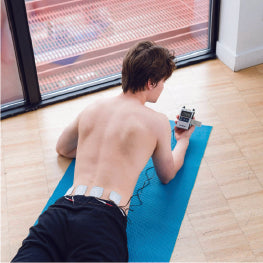
TENS Therapy
Transcutaneous Electrical Nerve Stimulation, commonly known as TENS, is a small device that packs a big punch in hip bursitis pain relief. It works by sending low-voltage electrical currents through electrodes attached to the skin.
This interrupts the pain signals being sent to the brain, essentially "confusing" your nervous system and reducing your perception of pain. It's like a magic trick for your nerves.
TENS therapy is portable and can be used whenever you feel discomfort. Studies have shown that it can be as effective as some medications for pain relief, but without the side effects like drowsiness or gastrointestinal issues.
It's a versatile option that offers a drug-free alternative for managing hip bursitis pain.
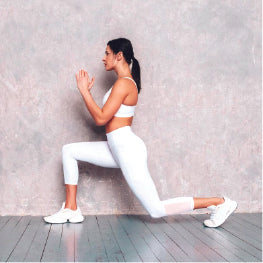
Stretching and Exercise
Physical activity might be the last thing on your mind when you're dealing with hip pain, but hear us out. Regular stretching and exercise can significantly improve your condition.
Gentle, low-impact exercises like swimming or cycling can help strengthen the muscles around your hip, providing better support and reducing stress on the affected bursa.
Consult a healthcare provider for a tailored exercise plan that suits your specific condition. The aim is to improve mobility without causing additional pain. Stretching can also improve flexibility and reduce stiffness, making daily activities less painful.
Find out more about specific exercises here.

OTC Pain Medications
Over-the-counter (OTC) pain medications like ibuprofen or acetaminophen can be a quick fix for hip bursitis pain. These medications work by blocking the enzymes that produce pain-inducing chemicals in the body.
While they offer fast relief, it's crucial to remember that they are not a long-term solution. Extended use can lead to side effects like gastrointestinal is sues, liver damage, or even an increased risk of heart problems.
Always adhere to the recommended dosage and consult your healthcare provider for a more sustainable, long-term treatment plan. OTC medications can be a part of your pain management strategy, but they shouldn't be the whole plan.
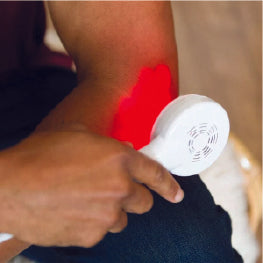
Red Light Therapy
Red light therapy is an emerging treatment option that's gaining traction for its potential benefits in pain management. The therapy involves exposing the affected area to low levels of red or near-infrared light. This is believed to trigger a biochemical effect in the body, leading to reduced inflammation and pain.
While more research is needed to fully understand its efficacy, preliminary studies are promising. Red light therapy can be done at home with specialized devices, making it a convenient option for ongoing treatment.

Physical Therapy
Physical therapy isn't just for post-surgery recovery; it's a versatile treatment that can significantly improve conditions like hip bursitis. A physical therapist can design a set of exercises tailored to your specific needs, focusing on improving mobility and reducing pain.
According to a study, physical therapy has a success rate of around 70% for treating hip bursitis. These exercises can often be performed at home, making it a convenient option for ongoing treatment.
The key is consistency. Regularly performing these exercises can lead to long-term improvement, reducing the need for more invasive treatments. It's a structured, scientific approach to reclaiming your mobility.
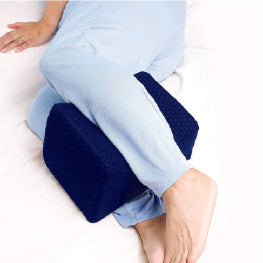
Pillows
You might be surprised to learn that something as simple as a pillow can make a significant difference in managing hip bursitis pain. Specialized pillows designed to support the hips can help align your spine and hips, reducing pressure on the affected bursa. These pillows can be placed between your knees while sleeping or used to elevate the affected hip.
The idea is to create an ergonomic sleeping environment that minimizes stress on your hips. It's a small change that can offer significant relief, making it easier to get through the night and start your day on a better note.
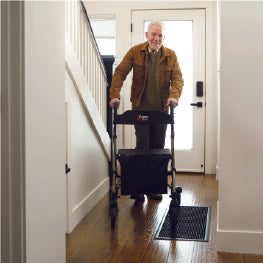
Assistive Devices
When hip bursitis flares up, even simple tasks can become a challenge. That's where assistive devices come into play. These aren't just tools; they're your allies in navigating daily life with less pain.
Let's break it down into two main categories: mobility aids and bathroom safety aids.
Mobility Aids
Walking canes and rollators aren't just for the elderly or those recovering from surgery. They can be incredibly useful for anyone dealing with hip bursitis. A walking cane can provide that extra bit of support and balance, reducing the load on your affected hip.
Rollators, or rolling walkers, offer even more stability and come with a built-in seat, allowing you to rest whenever you need to. These aids can be customized to your height and comfort, making them an essential part of your daily routine.
Bathroom Safety Aids
The bathroom can be a tricky place when you're dealing with hip pain. Raised toilet seats can make a world of difference. By elevating the height of the toilet, these seats reduce the amount you have to bend your hips, making it easier and less painful to sit down and stand up.
It's a simple modification that can make daily activities like going to the bathroom much less daunting.
Assistive devices are more than just tools; they're a way to reclaim your independence and improve your quality of life when dealing with hip bursitis.
Medical Treatment Options
When home remedies just don't do the trick, it's time to consult with healthcare professionals for more advanced treatments. These options often involve medical expertise and specialized equipment, but they can provide more long-term solutions for those suffering from persistent hip bursitis.
Here are some medical treatments that have shown significant promise.
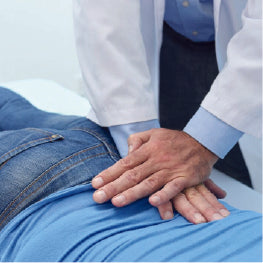
Physical Therapy or Chiropractor
Physical therapy is a tried-and-true method for treating hip bursitis, with a success rate of around 70%, according to the NCBI study. A physical therapist will guide you through a series of exercises tailored to improve your condition.
Chiropractic care is another option that focuses on spinal alignment and its impact on overall health, including hip pain. Both options aim to improve mobility and reduce pain without the use of medication.

Massage Therapy
Massage therapy is an effective treatment option for hip bursitis that focuses on relieving tension in the muscles and tendons surrounding the hip joint. By improving blood circulation and reducing muscle tightness, massage therapy can contribute to lower levels of inflammation and promote faster healing.
It is essential to consult with a certified massage therapist who has experience in treating hip bursitis to ensure the most effective treatment.

Corticosteroid Injections
Corticosteroid injections are a more aggressive form of treatment for hip bursitis and are often considered when other treatment options have failed. These injections deliver a powerful anti-inflammatory medication directly into the affected bursa to rapidly reduce inflammation and pain.
According to a study, corticosteroid injections have an over 80% success rate in treating Trochanteric bursitis. However, it's important to note that while effective, corticosteroid injections are not a long-term solution and come with their own set of risks and side effects.

Surgery
Surgery is considered the last resort for treating hip bursitis and is only recommended when all other treatment options have been exhausted. The procedure involves removing the inflamed bursa to alleviate pain and improve mobility. While surgery can be effective, it comes with risks such as infection and a lengthy recovery period.
It is crucial to discuss the pros and cons thoroughly with your healthcare provider before opting for surgical intervention.
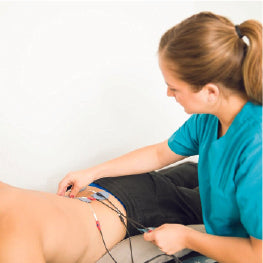
Low Shock Wave Energy Therapy
Low shock wave energy therapy is an emerging treatment option that utilizes shock waves to stimulate healing in the affected area. While it's a newer method, early findings are promising. The therapy works by sending shock waves into the tissue, which can stimulate cell regeneration and improve blood circulation.
This can lead to reduced inflammation and pain, offering another avenue for treatment.
The procedure is non-invasive and typically takes less than 30 minutes, making it a convenient option for those looking for alternative treatments. It's especially worth considering for individuals who haven't found relief through traditional methods and are hesitant to opt for more invasive procedures like surgery.
Prevention
Prevention is always better than cure, especially when it comes to a condition as debilitating as hip bursitis. Implementing preventive measures can save you from the discomfort and inconvenience that comes with this condition.
Here are some strategies that can help you keep hip bursitis at bay.
Practice Proper Exercise Form and Posture
The way you move matters. Poor exercise form and posture can put unnecessary strain on your hips, leading to or exacerbating bursitis. Consulting a fitness trainer or a physical therapist can provide you with the right techniques to ensure you're not harming your hips while trying to stay active.
They can guide you through exercises that strengthen the muscles around your hips, providing better support and reducing the risk of bursitis.
Wear Comfortable Shoes
Believe it or not, your choice of footwear can have a direct impact on your hip health. Wearing shoes that don't provide adequate support can lead to poor posture and hip strain. Opt for footwear with good arch support and cushioning.
If you're unsure about what to choose, a podiatrist can offer expert advice tailored to your needs.
Avoid Sitting/Standing for Extended Periods
Prolonged periods of sitting or standing can put a lot of pressure on your hips. Make it a habit to take short breaks to move around if your job requires you to sit or stand for long hours. Simple stretches and quick walks can go a long way in preventing hip bursitis.
Ergonomic furniture, like standing desks and supportive chairs, can also make a significant difference.
Maintain a Healthy Weight
Carrying extra weight puts additional stress on your hips, which can lead to bursitis. Maintaining a healthy weight through a balanced diet and regular exercise can significantly reduce your risk. If you're struggling with weight management, consider consulting a nutritionist for a diet plan that works for you.
By incorporating these preventive measures into your daily routine, you're not just reducing the risk of developing hip bursitis but also improving your overall health and well-being.
Navigating Hip Bursitis Treatment Options
We've explored a comprehensive range of remedies for bursitis in hip, from at-home therapies to medical interventions. The options are diverse, offering something for everyone, whether you're looking for immediate relief or a long-term solution. The crucial next step is to consult with healthcare providers.
They can help you develop a customized treatment plan that takes into account the severity of your condition, your lifestyle, and other individual factors. Your path to a more comfortable, mobile life starts with making informed choices.
Do you have questions, or just keen to learn more? Get in touch with us today, and be sure to sign up to our newsletter for more helpful articles like this!
About the Author

Brandon Landgraf is the Digital Marketing Manager for Carex Health Brands. He finds passion and fulfillment in creating content that enhances, improves, and enlivens others' quality of life. All of his written work is formulated to not only offer essential advice and tips but back it with proven studies and experts. His mission is to connect with readers and provide steps to make their lives better.
You can connect with him on LinkedIn here.
About Carex Health Brands
Carex is your one-stop shop for home medical equipment and for products that assist caregivers with providing the best possible support and care for their loved ones. Carex Health Brands has been the branded leader in in-home, self-care medical products for over 35 years. Our goal is to improve the lives of our customers by bring them quality products that bring dignity back to their lives. With our three nationally distributed brands, Carex Health Brands serves national, regional and independent food, drug and mass retailers along with wholesalers, distributors and medical dealers.

